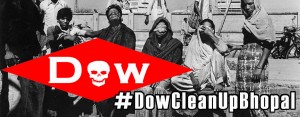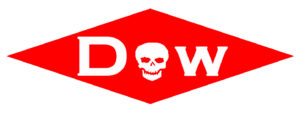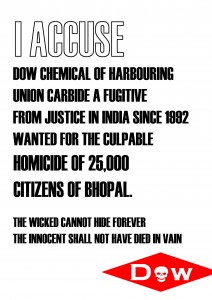The International Campaign for Bhopal Petition, which we are currently helping support, explains that the US Government successfully held BP to account, for its role on the Deepwater Horizon disaster in the Gulf of Mexico, whilst simultaneously sheltering the Dow Chemical Company from the clutches of the Indian courts.
Since December 1st 1987, Union Carbide has flouted every summons sent to request its attendance at trial, stating that, as a U.S. company, it does not accept India’s jurisdiction over it. Dow Chemical, current owner of Union Carbide, chooses not to present it to the courts despite notices requiring it to do so. BMA Executive Trustee, Tim Edwards, explains the nature of the corporate veil Dow draws between itself and Carbide. Should the petition succeed then we may yet see Dow in court having to explain the intricacies of the cloth it has cut for itself.
Beyond Belief
‘To keep coming back to the notion that you acquire a company where there is a bright line on the liability that was settled way beyond your time, and to hook you in to that event, it’s beyond belief that people are still trying that.’ Andrew Liveris, CEO of Dow Chemical, quoted by Bloomberg, March 1, 2012
The Dow Chemical Company knew exactly what it was getting when it swallowed Union Carbide Corporation.
Following completion of the $8.1 billion merger – a process which took 18 months – Dow officials claimed to have conducted an “exhaustive assessment”. But even a five minute browse of the internet would have discovered unaddressed mass homicide charges sticking pertinaciously to the one-time Fortune 500 multinational, charges from which it had already been on-the-lam for 9 years.
Dow executives didn’t have to depend upon their own handsomely paid lawyers to warn of the dangers. As soon as news of the planned takeover emerged, Bhopal survivor organisations wrote to Dow’s headquarters counselling that the company would be in the crosshairs if the merger went ahead.
The following spring, a court action by Dow shareholder Martin Statfeld observed that the two companies were withholding information concerning Carbide’s criminal and environmental liabilities from regulatory authorities in the U.S. and worried that they would eventually become Dow’s. Every member of Dow’s board was named in the action, which was successfully thwarted – on a technicality – by Dow’s lawyers.
The company’s AGM took place a few days after this suit was filed, in May 2000. Responding to shareholder questions, Dow’s Chairman Frank Popoff acknowledged that “the [Union Carbide] case has been reopened to some degree” in India and admitted that Dow was worried about double jeopardy. “That’s a tough question, one that we’ll have to deal with.”
Dow has been dealing with tough questions ever since, and no amount of disingenuousness has so far helped it answer them. However, few are aware that Union Carbide’s gassing of the Indian city of Bhopal was first a criminal justice issue, or that it remains so today. If medals were awarded for shameless cover-ups, Dow’s senior officials would by now be festooned with them.
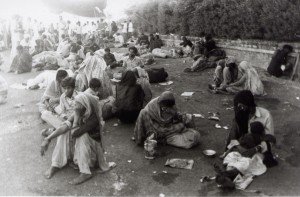
Photo: Kamlesh Jamini ( Jamini Photo Studio Bhopal )
The Gassing of Bhopal
The world’s worst industrial disaster began at an ultra-hazardous, under-designed and poorly maintained Union Carbide pesticides factory on the evening of December 2nd, 1984 when a large amount of water and contaminants mixed with over 40 tons of the highly reactive, volatile and toxic chemical methyl isocyanate (MIC). A rapid runaway exothermic reaction ensued.
Shortly after midnight, approximately 27 tons of MIC gas and other reaction products jetted from the top of a high smokestack, spread out, and drifted down close to the ground in a dense cloud that was carried by prevailing winds straight into the heart of Bhopal city, whose central train station lay less than a mile from the factory. Carrying an exposure threshold limit of 0.02 parts per million, MIC is five times more lethal than WWI chemical weapon phosgene[i] and 500 times more dangerous than hydrogen cyanide.[ii] Dispersion calculations indicate that MIC drifted at concentrations between 3000 and 10 parts per million for up to 3.5 miles from Carbide’s factory during the gassing of Bhopal.[iii]
Gas survivor and justice campaigner Rashida Bee described the night of terror:
Everyone was running all over the place shouting, “Run away, we will all die”… When we reached Pokhta Bridge our eyes had got swollen and we had so much trouble in our lungs that it felt as if someone had lit a fire in our body… Our eyes started to black out and we found it very hard to breathe… We could hear voices around us saying ”O God, please grant us death”. That day, death appeared desirable.
Evidence collected by Amnesty International suggests that, over the next 72 hours, at least 8,000 – 10,000 people were killed, with children and the elderly suffering the most. The chief cause of immediate death was pulmonary oedema, whereby victims were drowned by fluid produced within their own lungs. Other observed effects were bronchial and nasal lesions, heart attack, spontaneous abortion, blindness, racking cough, concussion, paralysis and signs of epilepsy.[iv]
By the time the gas had dispersed some 573,000 people had been exposed. Local emergency services were overwhelmed. Over the course of the first day, 20,000 people were treated in the 1,000 bed Hamidia Hospital alone. The inundation led to corpses of the dead being stacked “one on top of another like they were bags of wheat.”[v]
According to subsequent medical research, highly elevated rates of morbidity and mortality continue in the affected communities to this day, three decades later. [vi] There is a long-term prevalence of ocular and respiratory illnesses[vii]such as early age cataracts, diminished vision, breathlessness, persistent cough and chronic obstructive airways disease.[viii] MIC also entered the bloodstream, causing multi-systemic injuries to organs within the body.[ix] Chromosomal aberrations have been discovered, leading to expectation of cancers and the possibility of birth defects.[x] Gynaecological disorders such as uterine bleeding have been observed[xi], along with high levels of reproductive disorders. Neurological and neuromuscular affects, such as body aches, tingling in limbs, dizziness and loss of motor control, are common symptoms of gas exposure. [xii] Immunological impacts[xiii] have led to diseases such as tuberculosis manifesting at three times the national average.[xiv] Anxiety, memory loss and depression are regularly observed psychiatric effects.[xv] Evidence of second generational effects is now firmly established: some boys born to gas-affected parents suffer growth retardation, whereas hormonal chaos has afflicted girls. [xvi]
Crime without punishment
Crime No.1104/84 was registered, suo moto, by a Bhopal Police Station House Officer on December 3, 1984[xvii], less than 24 hours after the onset of the disaster, whilst hundreds of corpses still lay scattered across the old city.
Following a three year investigation by India’s Interpol unit, Union Carbide Corporation was formally charged with culpable homicide not amounting to murder – the equivalent of criminally negligent homicide in U.S. law – amongst other serious criminal charges. A series of summonses and arrest warrants were issued.
Shortly after the trial began, an Indian court dealing with responsibility for civil claims found that “it has to be held as having been more than prima facie established that it was the defendant UCC which had real control over the enterprise carrying on the particular hazardous and inherently dangerous industry at the Bhopal plant”.
Subsequent discoveries reveal that UCC directed four different phases of cost-cutting in Bhopal in order to retain its controlling stake of 50.9 percent in UCIL. As one example, $780,000 was saved changing MIC production from “continuous processing” to “batch processing”. The change necessitated storing enormous quantities of this highly volatile and deadly chemical for months on end, effectively creating the conditions that led to the disaster.
However, since December 1st 1987, Union Carbide has flouted every summons sent to request its attendance at trial, stating that, as a U.S. company, it does not accept India’s jurisdiction over it. Given that this stance is taken in defiance of basic tenets of international criminal law, the company’s position seems to be that it stands above and beyond the law.
Union Carbide was declared a fugitive from justice over 22 years ago and remains at large today. The outlaw Jesse James, whose notoriety echoes through history, spent 16 years on-the-hoof from the law. James was believed to have been implicated in the deaths of approximately 24, 984 less human beings than Union Carbide.
Sixty percent of Union Carbide’s time on the run from the rule of law has been as a wholly-owned subsidiary of Dow Chemical.
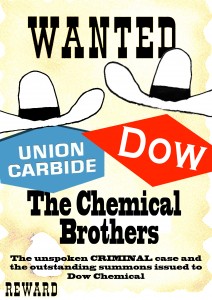
Now you see Carbide, now you don’t
“From day one we started to plan for the close of Carbide” said Dow Chemical CEO Michael Parker in June 2001, after Dow and Union Carbide merged in a deal in which all Carbide’s shares “shall no longer be outstanding, shall be cancelled and retired and shall cease to exist”. Parker also talked of over 300 “integration projects” which would serve to spread UCC’s assets over Dow’s eight global business units. Thus, Carbide would be absorbed into Dow, thousands of staff would be laid off and Carbide’s trademark name would vanish.
The new arrangement was summarised by Dow’s Head of Communications in an internal message to employees of the former Union Carbide and the new Dow:
“All business activities are done under the umbrella of a Dow business. We face the market as Dow. Reporters will be tempted to keep talking about Union Carbide. But we should discourage reporters from using the words Union Carbide, unless it’s reference to a historical activity. There should be no need for a trade press reporter to refer to Union Carbide, as we face the market as Dow. They should not call a product a ‘Union Carbide product’. All products are sold as Dow products now. Any current or future activity of a business is done as Dow.”
Dance of the Corporate Veils
A decade later, however, Dow’s entirely contradictory position is that “Dow and UCC are separate companies”.
Summoned to answer a gas disaster claims case in the Supreme Court of India, Dow complained that the suit had been brought against it due to “an erroneous assumption that UCC has merged into Dow.” Instead, Dow deposes Union Carbide to be an “independent corporate entity”, with Dow itself a mere “shareholder”.
As reports are filed in its name with financial regulators in the US, Union Carbide does still appear to exist as a ‘legal entity’. But while US financial accounting standards require that the various “operating segments” of a corporation report results separately, Union Carbide’s regulatory filings declare that it is unable to comply since “Union Carbide Corporation’s business activities comprise components of Dow’s global operations rather than stand-alone operations . . . there are no separable reportable business segments for Union Carbide.”
So if Union Carbide is not functionally separate from Dow, what kind of entity is it?
The 2001 deal with UCC was termed a ‘merger’ within Dow’s own public statements. To merge is to “combine to form a single entity”. Due to the merger, shareholders in Dow became shareholders in UCC; UCC shareholders became Dow shareholders. All assets and liabilities of both companies were combined using ‘pooling of interests’ into one consolidated account. Union Carbide’s pre-existing debts and obligations became registered as charges upon the corporation’s consolidated accounts; this fact was borne out on January 9th, 2002, when the settling of an asbestos suit filed against Union Carbide in Texas, knocked over $7 billion from Dow’s own share price.
Union Carbide declares itself to be principally a Texan business to India’s courts. But the New York Registrar of Corporations, where the company has been listed for almost a hundred years, reveals its head office to be Midland, Michigan, where Dow also happens to have its head office.
Tax filings in Texas detail the company’s officers and board directors. Almost every single Union Carbide board director listed since the merger is either based 1,137 miles away in Midland, Michigan or is an acting Dow manager, or both. Every year since the merger, Union Carbide’s CEO and Chairman has been, without exception, simultaneously a Dow manager.
When Courts are asked to ‘lift the corporate veil’ between companies they apply a number of tests to discern the substantive reality behind the corporate form. One of those tests seeks to establish who benefited from the change in form. Since Dow announced the merger with Union Carbide, sales have risen 150% to stand at $57 billion annually. Union Carbide’s annual sales began at $6.5 billion in 2001, and are declared to be $6.9 billion in 2014. Of these sales, 98% are now direct to Dow itself.
Of the various means for piercing the corporate veil between different segments of a corporation the most powerful is the charge of fraud and abuse of the corporate form.
Court submissions discovered by Bhopal campaigners reveal that throughout the 1990’s, and unable itself to sell directly due to the unresolved criminal matter, Union Carbide employed a third party to distribute its products within India and thereby avoid a property attachment order intended to force its attendance at trial.
Following the merger, the pre-existing contractual relationship with the third party presented Dow’s Indian holdings with a business dilemma. Dow considered distributing Union Carbide produced goods in India directly, thereby using Dow’s own ‘separate’ corporate identity to enable Union Carbide to evade criminal trial. In April 2001, an employee of Dow Chemical Pacific outlined the proposed solution: “[p]resuming the product ships directly from USA to India, my suggestion is to selling the product under Dow legal entity with Dow label and document will be a good way to proceed.”
A year after the merger, Dow cancelled the contract with the third party and took over all trade in Union Carbide products in India.
Dow informs Indian courts that these are bought in “fair value transactions” outside of India and are therefore not Union Carbide property when in the country.
Dealing with Double Jeopardy
Union Carbide was a fugitive when Dow merged with it and is a fugitive now. If Dow is not Carbide, then Dow is harbouring a fugitive, a distinct offence under Indian law. If Dow is Carbide, Dow is also a fugitive.
Which is it to be?
When the criminal court attempted to answer this question in 2004, Dow India informed the court that it had “no nexus” with either Dow Michigan or Union Carbide. In 2005 the court issued a summons to Dow Michigan. Shortly after, Dow India applied for a freeze on the summons, arguing that Dow Michigan had “no nexus” with Union Carbide. The court granted the freeze, which remained in place until October 2012. Dow Michigan has now been ordered to attend court in November 2014 and explain the whereabouts of its absent subsidiary.
Not content with obstructing legal process by a dizzying use of multiple corporate forms, Dow managers sought to force Indian Ministers, including the Prime Minister, to intervene in legal proceedings and end legal pursuit of Bhopal liabilities against “non-Indian companies”. Bilateral US-India trade organisations and US officials were employed to lever additional pressure, and a one billion dollar investment programme was made conditional upon Indian complicity in getting Dow off the hook. The scheme failed after right-to-information work by Bhopal survivor groups exposed the whole farrago.
The failure of Dow’s extra-judicial attempts to end legal proceedings against it in India have had a disastrous effect on its plans to invest in South Asia. In spring 2014, Dow managed to exclude a shareholder resolution on Bhopal by arguing that its statements asserting that Bhopal was causing no financial, operational or reputational impact upon it amounted to an open and complete response to its stakeholders. Though shareholders presented irrefutable evidence of the increasing financial, operational and reputational impact of Bhopal upon Dow, Dow management excluded the resolution 2014 proxy materials. A record of the battle between shareholders and Dow can be found on the SEC website: http://www.sec.gov/divisions/c…
In summary, shareholders presented the following findings to the SEC:
- Bhopal has prevented Dow from pursuing a $5 billion strategic investment in India, whose specialty chemical sector is predicted to grow 17% annually and become the 4th largest market globally over the next decade.
2. Dow’s own documents show that the company has lost at least $300 million in India between 2008-2016 due to Bhopal.
3. The Bhopal legacy has caused Dow’s Core Brand rating to fall 300% in six years, during which time Dow has made it into the top 20 corporations targeted by activists globally.
4. Yet management continues to mislead shareholders and regulatory authorities by denying that Bhopal is causing any financial, operational or reputational impact upon the company.
14 years after UCC merged into Dow, the strategy adopted to deal with the question of jeopardy remains the same. It arguably involves harbouring a fugitive; obstructing justice; becoming an accessory after the fact; subverting legal orders; backroom dealing; drawing the corporate veil; and deliberately misleading investors, regulators and the international public.
As a direct consequence of Dow’s strategy, the agonized, untimely and wholly avoidable deaths of more than 25,000 human beings remains uninvestigated, unresolved and unpunished.
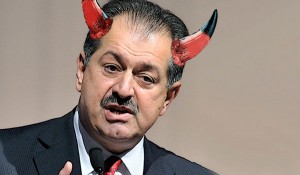
Gassed, Poisoned, left to Die
Meantime, the ongoing poisoning of another 40,000 people in Bhopal continues unabated.
Because even if the 1984 gas disaster had somehow been averted, Union Carbide’s chemicals would still be damaging the bodies of thousands of families in Bhopal.
According to former workers of the factory over 15 years a massive amount of chemical substances formulated in the plant – including pesticides, solvents used in production, catalysts, and other substances, as well as by- products – were routinely dumped in and around the factory grounds, causing pollution of the soil, water and air.[xviii] Between 1969 and 1977, byproducts and wastes were dumped into pits situated in the factory premises, covering 21% of the total site area. In 1977, disposal ponds were constructed 400 metres north of the plant, covering an area of 14 hectares. Several thousand tonnes of toxic wastes and by-products were henceforth dumped at these sites.[xix] By 1982, UCIL was informing UCC of major leakages from the ponds.[xx] In 1983, following the death of several cattle, a local attorney wrote to management of potential legal action due to contamination threatening the health of local communities.[xxi] The management termed the claims “baseless”.
By 1989, UCC had undertaken secret tests of soil and water around the plant and discovered the samples to be lethally toxic, but its managers covered up the results and did nothing to address the sources of pollution or warn local communities drinking from wells the company had already identified to be suspect. Instead, in 1994 UCC divested itself of its Indian shareholdings and declared the pollution it had collaborated in causing and covering up to be the State government’s problem.
Today, the toxic plume caused by thousands of tonnes of wastes has contaminated community wells with carcinogenic and mutagenic organic chemicals at least five kilometres away from the plant site, affecting 40,000 local residents.
Union Carbide and Dow continue to contest suits in India and New York attempting to make them take responsibility and end the poisoning. Many of those being steadily poisoned today were also gassed in 1984.
No Justice, No Business
Union Carbide declares itself to be part of Dow’s global business. Dow’s global business is contesting ‘polluter pays’ whilst thousands of innocent families continue to be poisoned. Dow’s global business, therefore, is a fugitive from India, on the run from criminal charges.
The Union Carbide shareholders of 1984 couldn’t reasonably have been expected to know that management had created a disaster-in-waiting in Bhopal that would ensue before the year-end. But, the Dow Chemical shareholders of 2014 are complicit in management’s policy of liability evasion at all costs, including but not limited to human, ethical, social and environmental, a policy that extends, perpetuates and deepens the suffering of a city that has already suffered enough.
Despite three decades worth of legal travesties, dirty politics and gross miscarriages of justice, Bhopal survivors have maintained an unbending determination to obtain remedies and restitution via legal processes. Purely as a result of survivor group interventions, criminal, civil and environmental cases remain alive in Indian and U.S. jurisdictions, and Dow has made substantial material losses through abandoned investment programmes in India.
In response, Dow’s Indian subsidiary has itself filed several legal suits against Bhopal survivor groups – which include some of the poorest people in the world – the latest of which includes a demand for hundreds of thousands of dollars.
[i] Larry Everest, Behind the Poison Cloud, p.21
[ii] OSHA guidelines for hydrogen cyanide, accessed at http://www.osha.gov/SLTC/healthguidelines/hydrogencyanide/recognition.html
[iii] Karlsson, E., N. Karlsson, G. Lindberg, B. Lindgren, and S. Winter, “The Bhopal catastrophe – consequences of a liquefied gas discharge.” Defense Research Institute, Sweden, 1985. NTIS ISSN 0347-2124.
[iv]Dr Heeresh Chandra, who performed over 100 autopsies at Hamidia Hospital in the days following the disaster, reported that there was “a gross increase in the weight of the lungs of up to three times the normal. The entire respiratory tract showed pathological changes. The lungs were heavily water logged and had a distinctive cherry-red colour… The mucosa was intensely congested. The trachea and the major divisions of the bronchi revealed necrotizing or ulcerative changes.”
[v] Dr. Ashok Gupta, quoted in Larry Everest, Behind the Poison Cloud, p.15
[vi] Amnesty International,“Clouds of Injustice”, pps. 10-12
[vii] R Dhara, “Health Affects of the Bhopal Gas Leak: a Review”, New Solutions, Spring 1994
[viii] “The Bhopal Gas Tragedy, 1984 – ?” Report from the Sambhavna Trust, 1998
[ix] S Srimarachari et al, op cit. pp. 298-293
[x] “Health Affects of the Bhopal Gas Leak: a review”, op cit, p.40
[xi] Shilotri NP et al, “Gynaecological and obstetrical survey of Bhopal women following exposure to methyl isocyanate”, J Postgrad Med, 1986; 32:203-5
[xii] International Perspectives in Public Health, vol. 11 & 12, 1996
[xiii] AK Saxena et al, “Effect of exposure to toxic gas on the population of Bhopal: IV- Immunological and chromosomal studies”, Indian journal of experimental biology, 26 pp. 173-6
[xiv] C Sathyamala et al, “Against all odds: Continuing effects of the toxic gases on the health status of the surviving population in Bhopal”, December 1989, p.10
[xv] International Perspectives in Public Health, op cit, pp. 36-40
[xvi] Ranjan N et al. “Methyl Isocyanate Exposure and Growth Patterns of Adolescents in Bhopal”, JAMA 2003;290:1856-57
[xvii] Committee on Government Assurances report, op cit. ch.2 para. 7
[xviii] Affidavit submitted in the Southern District Court of New York by former UCIL engineer T. R. Chauhan.
[xix] Assessment of Contaminated Areas Due to Past Waste Disposal Practises at EIIL, Bhopal, report by the National Environmental Engineering Research Institute, Nagpur, India, October 1997
[xx] Telex from UCIL to UCC, Danbury, Connecticut dated 25 March 1982, accessed at http://www.bhopal.net/oldsite/carbidedocuments/contamination/7137-x1.gif . Some days after a first leak was communicated, the Phase II evaporation pond was still leaking, causing great concern, and the emergency pond was also discovered to be leaking.
[xxi] Amnesty International, “Clouds of Injustice” p.44

